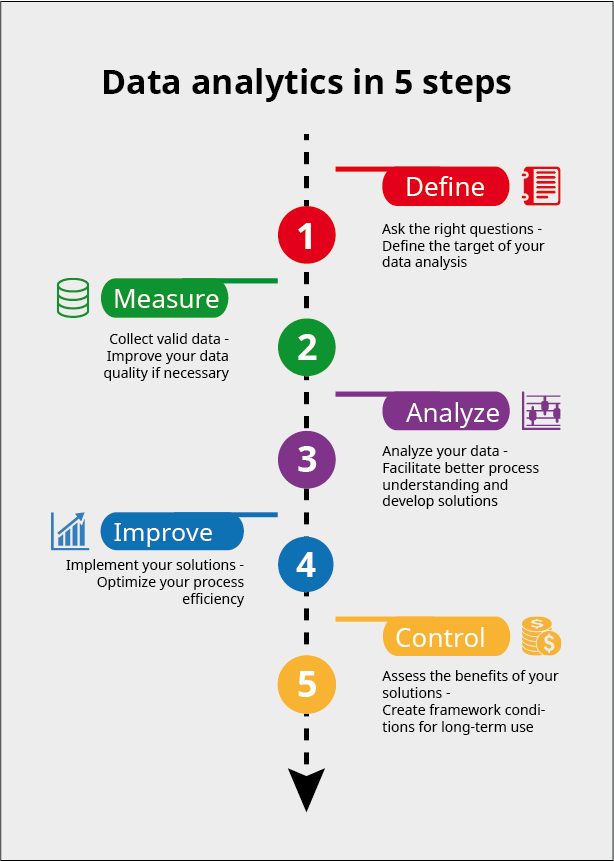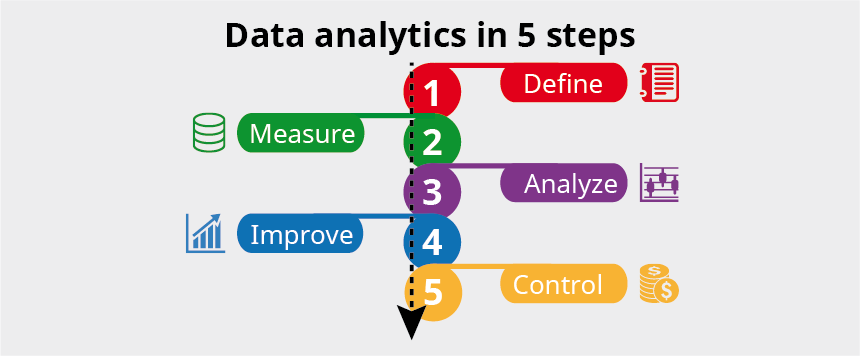When a data analysis becomes a must
Post no. 1 – The familiar buzzwords big data and Industry 4.0 inevitably play a part again here. You’ve probably heard them so many times recently, but it makes sense to address the issues nevertheless. That doesn’t mean you have to go for big data straight away, but at the same time it doesn’t hurt to get to grips with whatever data you have – and in the future that will truer than ever. My advice is to start now with data analysis before it’s too late!
Data analysis in 5 steps
Anyone who’s ever carried out a data analysis needs no telling that the time and effort can often be considerable. Maybe not always, but certainly in a lot of cases, the benefits are well worth all the hard work. And if you take the time upfront to think about the quality of your data – and the most efficient way to collect it – you can save yourself quite a few problems later. Once again, experience is immensely important.
You can find plenty of information in the VDI Big Data Expert Committee’s status report headed “Opportunities with big data – Best practices”. There are undoubtedly many different ways to represent the step sequence in data analysis projects. The VDI method corresponds very closely to my own experience, which is why I’ll lean heavily on it in my description.

The diagram above shows the various steps or phases in a data analysis project based on the well-known, and internationally used, Six Sigma DMAIC method. The Define – Measure – Analyze – Improve – Control toolkit is enhanced here with methods and procedures which are also suitable for processing large quantities of data.
Stick with me – or rather, time to get started!
You’ve probably noticed that I’ve been avoiding the term “big data” and have tended to talk instead about data analysis. This workflow is ideal for big data projects, of course. It’s equally suitable for smaller projects, though, and if you’re new to this kind of thing, that’s where I’d recommend that you begin! Just follow me and I’ll take you step by step through the five phases of a data analysis in this special series. Let me start by giving you a short summary of what awaits you.
Step 1: Define: Is a data analysis really worth the effort and how should you structure your project?
Step 2: Measure: What special points do you need to consider when selecting the data and where do the stumbling blocks lie?
Step 3: Analyze: What aspects should you be aware of when you carry out a data analysis?
Step 4: Improve: How can the results of your analysis be implemented in efficiency-enhancing solutions?
Post will be available on February 7, 2018!
Step 5: Control: How can you assess the efficiency of your solution and how can you estimate the potential benefits upfront?
Post will be available on February 14, 2018!
Have we succeeded in arousing your interest? Stick with me for the next blog posts – I promise you won’t be disappointed! Do you have any questions, observations, criticisms or suggestions? If so, just write us a comment. Your feedback is always welcome.
We look forward to hearing from you. We’ll be in touch again soon.
Did you miss a blog post?
No problem – all posts in this series can be accessed here:
– Post no. 1: “Analyze your data – Success in 5 steps”
– Post no. 2: “Analyze your data – Step 1: Define”
– Post no. 3: “Analyze your data – Step 2: Measure”
– Post no. 4: “Analyze your data – Step 3: Analyze”
– Post no. 5: “Analyze your data – Step 4: Improve”
– Post no. 6: “Analyze your data – Step 5: Control””




